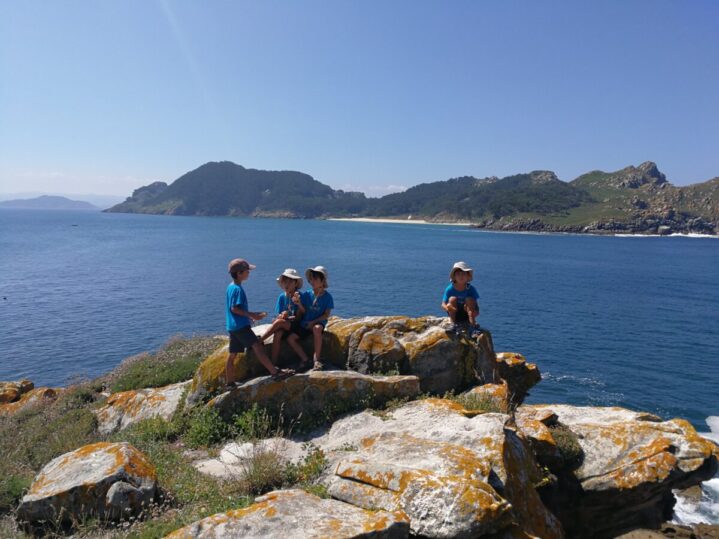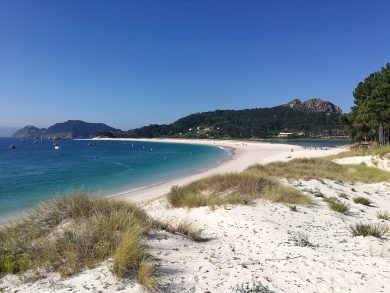
The Cíes Islands
Galicia, that rugged, rain-soaked corner of Spain that looks more Irish than Iberian, would seem an incongruous location for ‘tropical island’ tropes: beaches as fine and white as baby powder, pellucid waters ranging from teal to turquoise, that sort of thing. Yet here they are, three islands whose heavenly beaches routinely make it onto the most-informed “best of” lists. This sort of praise is hardly new. The Romans called them “The Islands of the Gods.” Their unexpected, almost equatorial beauty is what makes the Cíes Islands so surprising and so special.I first read about the Cíes in a gushing 2007 Guardian article. I adore near-offshore islands, loved the Cíes’ peculiarity and had never forgotten them. But I had lazily assumed that we could just pitch up at the ferry terminal in Vigo and purchase our tickets. Thankfully, Nori had looked into the details while we were still in Portugal. First, she had to submit an online permission request for our family – only 2,200 visitors are allowed on the islands daily. A few days later, she received an approval email with a QR code. Only then was she was able to buy our ferry tickets.

Even then, we still nearly missed the Cíes Islands. With the European sun dropping at an unreasonable 10pm in July, we had slipped into a bad habit of late nights and later mornings. The boys couldn’t sleep until it got dark, which forced Nori and I to stay up well into the madrugada (early morning) to do the hundred things that couldn’t be accomplished with four screamers rampaging about. When I awoke at 8am, I knew it would take a miracle and incessant shouting for us to make the 9:40am ferry. Both occurred. The voyage to the Cíes Islands lasted only 40 minutes and cost €18.50 per adult and €6 per child round trip. On a clear day, you can see the islands for the duration. Most of the passengers on our boat went straight to the upper, open deck – both to start catching some rays and to potentially see dolphins, who often hunt and play near the mouth of the Vigo estuary. Still hot from our last minute dash to the pier, we claimed a table inside the lower, enclosed deck and got out the UNO cards.

Las Islas Cíes (Illas Cíes in the local Gallego dialect) impress from the moment you arrive. The ferry pier stood at the north end of Rodas Beach, a 1.2km arc of the whitest, squeakiest sand. Rodas is the only natural link between Monte Agudo (Sharp Mountain) and O Faro (The Lighthouse) Islands. It’s a bit hard to describe. But from the air, the beach looked like a white hairband supporting novelty moose antlers (the two islands). Behind the beach, a large, crystal clear lagoon thrived with many varieties of fish and seaweed. There are no villages on the islands. No roads and no cars. You can’t ride your bike either. Everybody must walk, but you must remain on the small number of sanctioned trails that wind along the coast to beaches and lighthouses. There are no hotels – if you want to overnight, you must stay at the 800 spot campsite. If you camp, you can’t play music, throw a party or light campfires. There are casual restaurants at the ferry and the campsite, but they’re expensive – which is why most people bring fat-tired beach wagons full of picnic food. You need to bring your own water too. There are no trash bins on the island; whatever you bring in you must take out.

If all those rules sound a bit stifling, they are. But it would be impossible to argue with the results: excluding the slicks of seagull poop below their favourite roosts, the trails were clean, the beaches were litter free, and the water devoid of the plastic bag ‘jellyfish’ and bobbing PET water bottles we had seen everywhere else. I wanted to get a nice walk in before the midday heat. So we followed the beach wagon battalion along a wide trail that skirted the edge of the Monte Agudo (Sharp Mountain) Island before crossing to Faro (Lighthouse) Island over a 200 metre concrete causeway that partially dammed the lagoon and protected Rodas Beach from big waves and erosion. Drake and Kiva had to pee, so I helped them off the causeway and across the rocks to a more private location. Dark waves were shattering in cascades of froth on Monte Agudo’s rocky west coast. The cloud muffled light gave the cliffs a sombre majesty. I yelled at Tai and Logan to join us, and took one of my favourite photos of the trip. The whole time I heard a shrill whistling. Then I realised that a park volunteer was blowing the whistle at us! I shook my head and did a ‘oh please!’ motion with my hand. Where we had been was not remotely dangerous. Our footfalls had not done a bit of damage. But those were the rules.

When the trail forked, we followed the lower path past the pretty Playa de Nuestra Señora (Beach of our Lady) and along the coastline until it ended at a little picnic spot set among rocks emblazoned with orange lichen. Across the narrow strait to the south, San Martino Island sat green and un touristed. You could only reach it by private boat, and there were no campsites on the island. To the west, the tiny Faro da Porta (Gate Lighthouse) watched over the strait while high above us, the Faro do Monte (Mountain Lighthouse) commanded views of all three islands and much of the Vigo estuary. Just beautiful.I’ve seen people describe the Cíes Islands as the “Maldives of Spain” or the “Spanish Seychelles” but both are a stretch. To begin with, the water surrounding the Cíes is cold. Wetsuit cold. I’m from North Idaho and even I gasped when the family jewels were first submerged. Instead, what the Cíes Islands resemble perfectly – complete with stunning beaches, orange stained boulders and gum trees – is Tasmania’s Freycinet Peninsula and Bay of Fires.
After a classic lunch of sun heated hot dogs, we returned to Our Lady’s Beach and spent the next 3 hours wading cautiously into the water and then rushing out before hypothermia could set in. By early afternoon, the beach was as crowded as Bondi on a Saturday. A group of scuba novices wearing swim fins waddled backwards into the water. (I had done some free diving and saw only rocks and a few tiny fish). Two handsome young brothers did backflips off the barnacle covered rocks. Pale Spanish breasts were set free. Everyone was polite. No one left trash on the beach. I was impressed.Spain isn’t exactly known for its environmental stewardship. It’s Costa del Sol is synonymous with overdevelopment and despoliation. Mercifully, the Cíes will never become another Benidorm or Marbella. In 1980, the islands were declared a nature reserve. In 2002, they joined the newly created Atlantic Islands National Park, which carried even stricter regulations. As we had seen, the Galician authorities were taking these rules very, very seriously.

Around 85% of the area of the Atlantic Islands Park lies underwater, protecting “one of the richest (maritime) ecosystems in the entire Galician coast.” That said, I wasn’t terribly impressed with the terrestrial wildlife. Apart from a few sparrows and finches and the odd cormorant, the only animals we observed on the islands were seagulls. Lots and lots of big, guano bombing seagulls. Apparently, the Cíes host Europe’s largest colony of yellow footed seagulls. Now, I’m all for protecting endangered species – but seagulls? Seagulls are as omnipresent as pigeons. But while pigeons are endearingly dumb, seagulls are irredeemable jackasses. Aren’t all seagulls yellow footed? With a few hours to kill before our ferry returned to Vigo, we found a secluded spot between the pier and “German” Beach (the nudist one) and uncorked a bottle of Douro Valley red.
While the boys played war with pine cones, Nori took a nap and I caught up in my travel journal. On cue, the man sitting alone at the picnic bench next to us brought out his guitar and serenaded us and the seagulls. Normally, I would have resented the aural intrusion. But he played and sang gently, somehow magnifying the peace in that little pine grove. In this age of low cost airlines, TripAdvisor and Instagram, remote and beautiful places are being discovered, swarmed, trashed and trampled at a frightening pace. While I considered the Cíes Islands’ myriad rules too proscriptive, the sad fact is that many people need to be told how to behave in the outdoors. I left the “Islands of the Gods” thinking that hard visitor limits and rules based tourism are exactly what many popular spots in Asia need.



